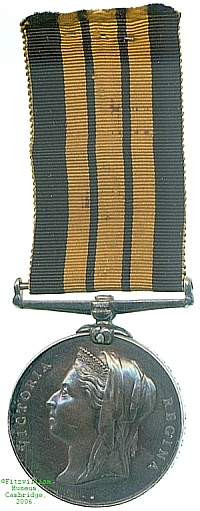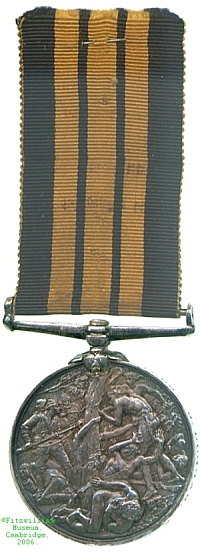
Obverse, a bust of Queen Victoria with crown and veil

Reverse, a scene of bush fighting around a tree with a fallen African to the fore

Obverse, a bust of Queen Victoria with crown and veil |

Reverse, a scene of bush fighting around a tree with a fallen African to the fore |
Peace-keeping operations in the British possessions in Africa, as anywhere else, required a large number of small campaigns, several of which, from 1892 until 1900, were considered to merit this medal, which in terms of design is a continuation of the Ashantee War Medal. Recipients who held that medal already were therefore awarded only extra clasps.
The coastal strip of what is now Kenya was in the 1880s part of a territory of the Sultan of Zanzibar known as Zanj. Its extent was settled by German and British treaty in 1886, but in 1890 the Heligoland-Zanzibar Treaty saw German interests in the area ceded wholly to Britain, and Zanzibar became a British protectorate that year. The Zanj was thereafter subsumed into the administration of British East Africa, which would later become modern Kenya.
Until the opening of rail links, trade in this area had to be carried out by caravan, which was frequently subject to raiding by tribes from further inland. One such tribe was that of Chief Rashid of M'wele, and a quantity of British forces were occupied in suppressing his efforts between 1895 and 1896.
The medal for this campaign is almost unique among British campaign medals as, although it is of the regular East & West Africa type, no bar was issued. Instead the campaign's identity was engraved at the top of the rim. This makes the medal impossible to distinguish from the Ashantee War Medal when worn.
This example was awarded to Able Bodied Seaman J. Duggan who served aboard HMS St George, which joined the campaign fresh from that on the Brass River. (Her complement later earnt another medal which has ended up in the Watson Collection.) Lester Watson purchased the medal from the London dealers Spink at some point before 1928.